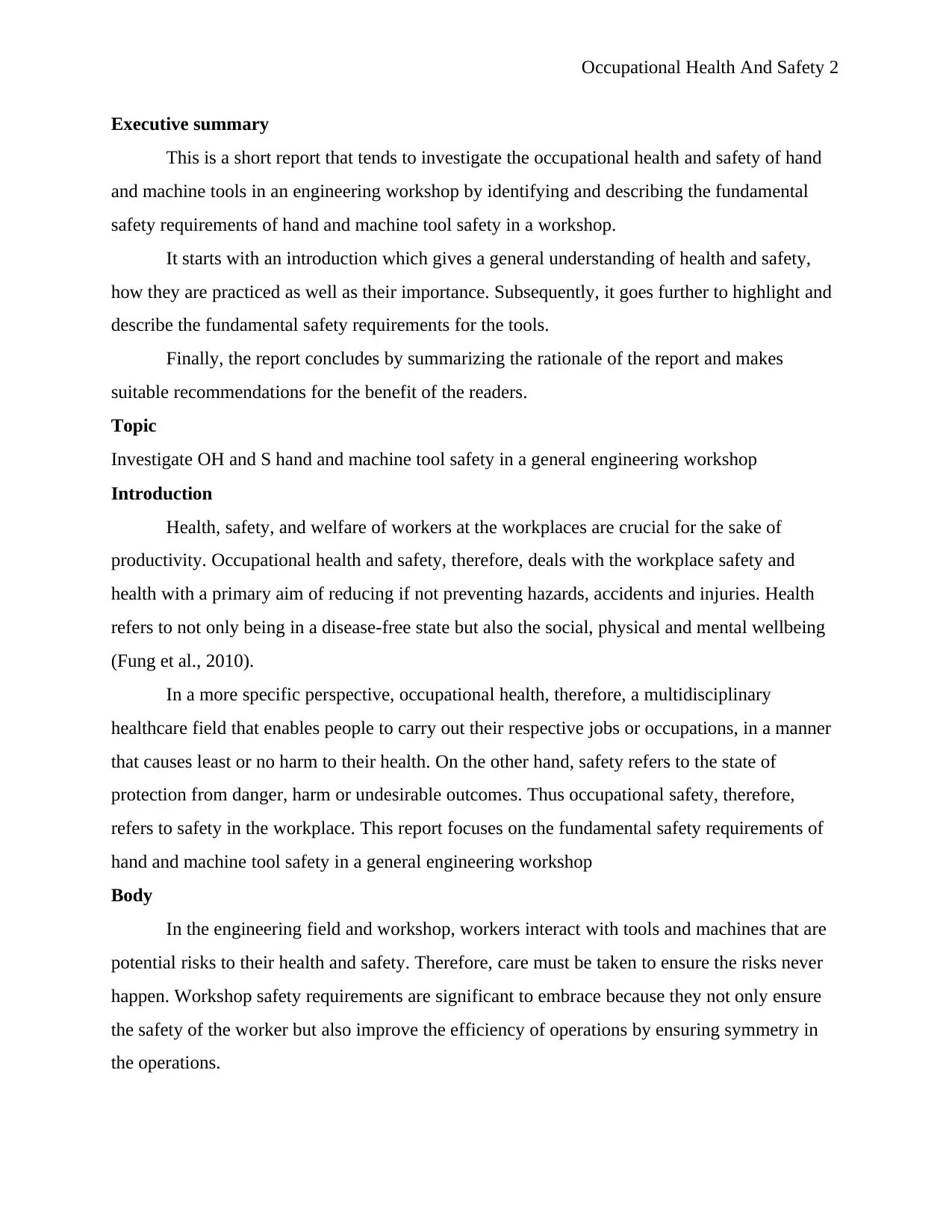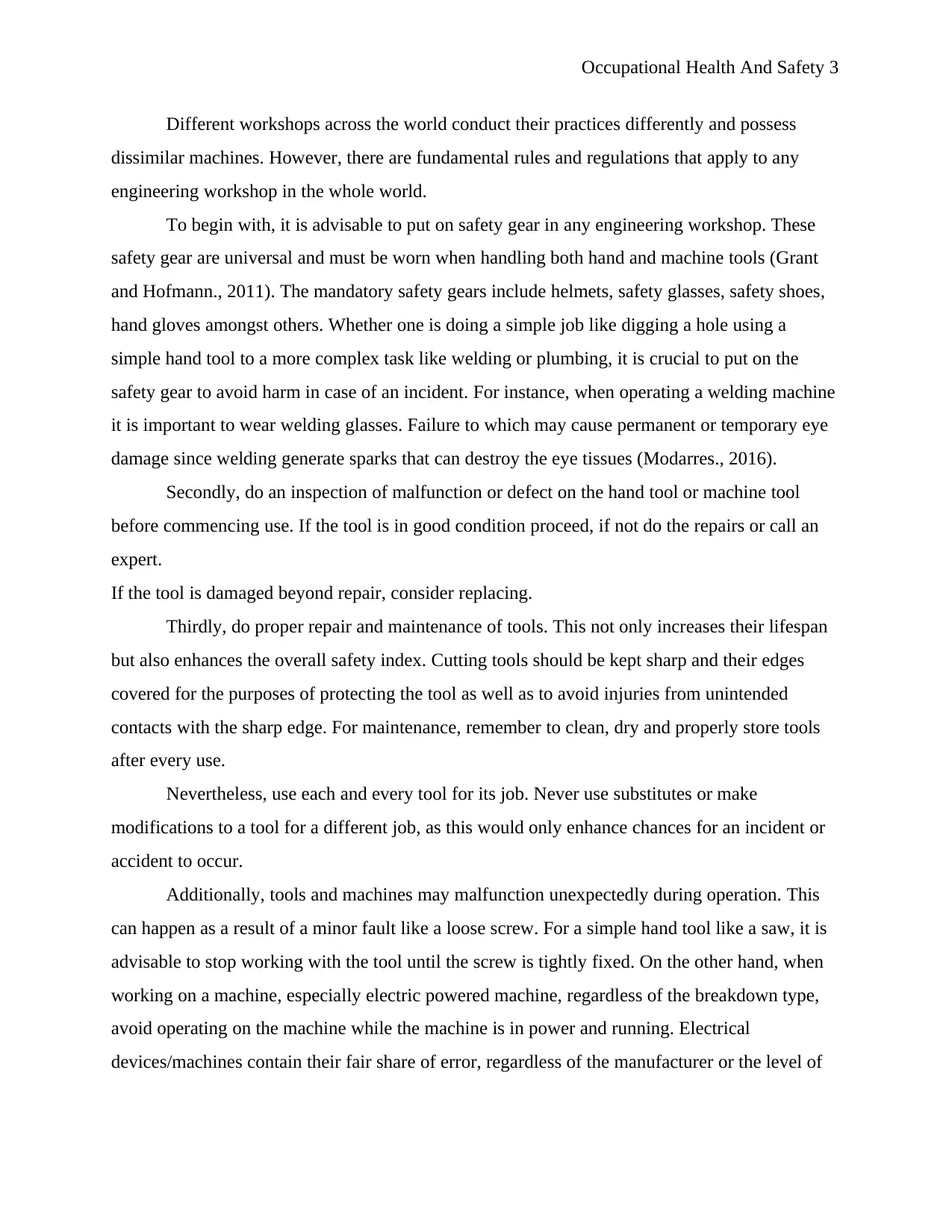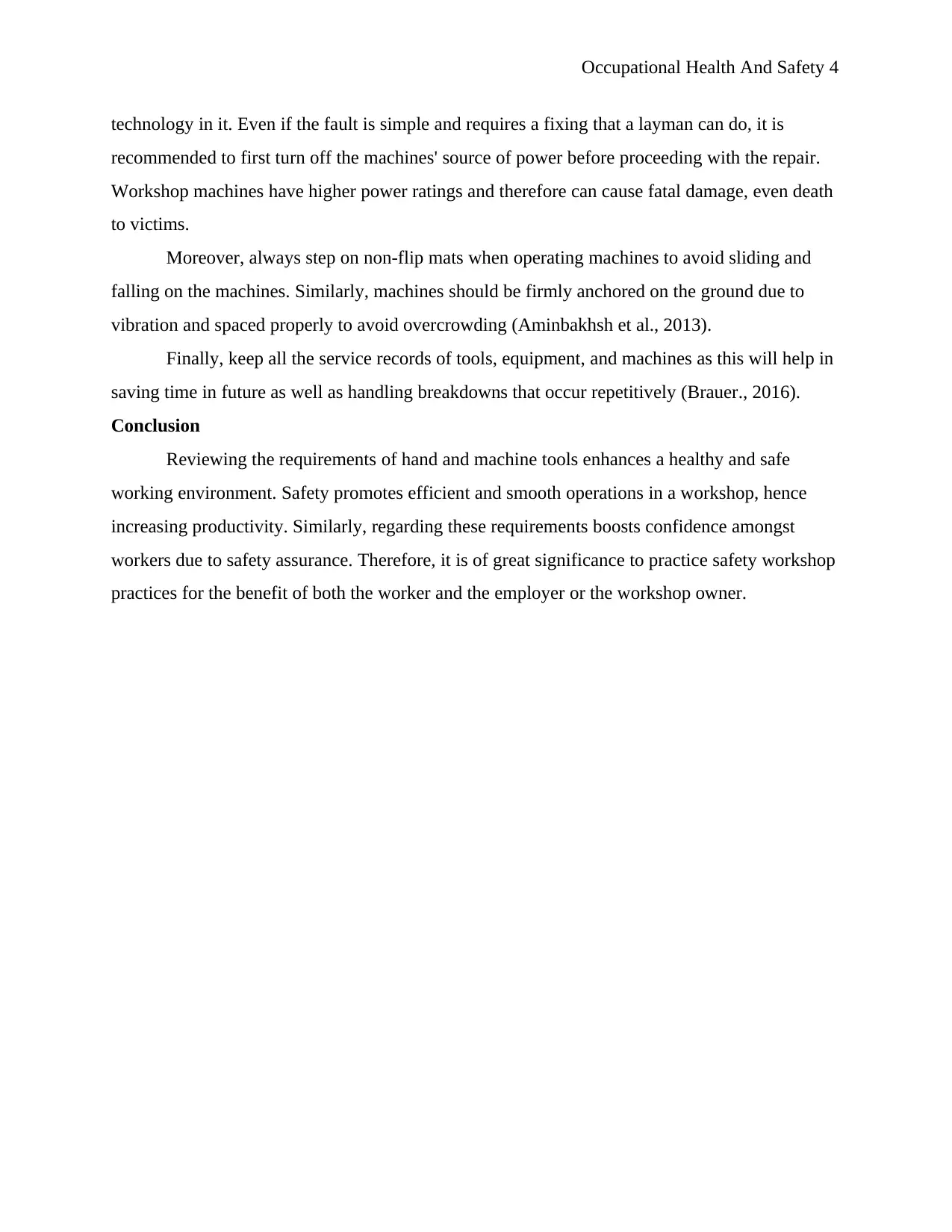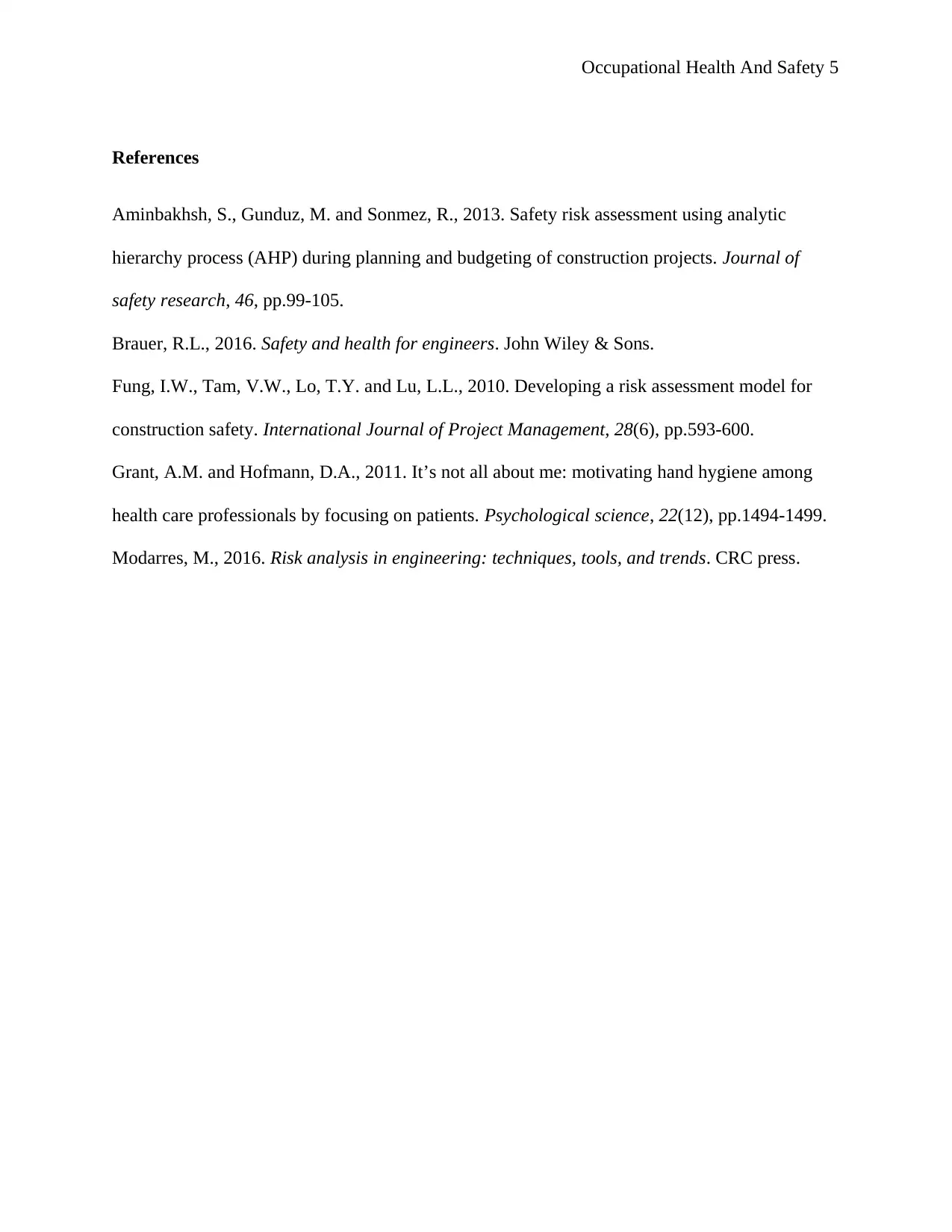HEETCM104 Report: Investigating Hand & Machine Tool Safety OHS
VerifiedAdded on 2023/06/13
|5
|1210
|77
Report
AI Summary
This report investigates the occupational health and safety aspects of hand and machine tools within a general engineering workshop, emphasizing the critical safety requirements. It begins with an introduction to occupational health and safety, highlighting its importance in preventing workplace hazards, accidents, and injuries, while also underscoring the significance of physical, social, and mental wellbeing. The report then delves into the fundamental safety requirements for hand and machine tools, including the mandatory use of safety gear like helmets, safety glasses, and safety shoes, as well as the importance of regular tool inspection, proper maintenance, and correct usage. It further addresses the procedures for handling tool malfunctions and breakdowns, particularly with electrical equipment, and emphasizes the need for maintaining service records. The report concludes by reiterating the importance of adhering to safety practices to foster a healthy and safe working environment, boost worker confidence, and enhance overall productivity. Desklib offers more resources for students.

OCCUPATIONAL HEALTH AND SAFETY
By Name
Course
Instructor
Institution
Location
Date
Occupational Health And Safety 1
By Name
Course
Instructor
Institution
Location
Date
Occupational Health And Safety 1
Paraphrase This Document
Need a fresh take? Get an instant paraphrase of this document with our AI Paraphraser

Executive summary
This is a short report that tends to investigate the occupational health and safety of hand
and machine tools in an engineering workshop by identifying and describing the fundamental
safety requirements of hand and machine tool safety in a workshop.
It starts with an introduction which gives a general understanding of health and safety,
how they are practiced as well as their importance. Subsequently, it goes further to highlight and
describe the fundamental safety requirements for the tools.
Finally, the report concludes by summarizing the rationale of the report and makes
suitable recommendations for the benefit of the readers.
Topic
Investigate OH and S hand and machine tool safety in a general engineering workshop
Introduction
Health, safety, and welfare of workers at the workplaces are crucial for the sake of
productivity. Occupational health and safety, therefore, deals with the workplace safety and
health with a primary aim of reducing if not preventing hazards, accidents and injuries. Health
refers to not only being in a disease-free state but also the social, physical and mental wellbeing
(Fung et al., 2010).
In a more specific perspective, occupational health, therefore, a multidisciplinary
healthcare field that enables people to carry out their respective jobs or occupations, in a manner
that causes least or no harm to their health. On the other hand, safety refers to the state of
protection from danger, harm or undesirable outcomes. Thus occupational safety, therefore,
refers to safety in the workplace. This report focuses on the fundamental safety requirements of
hand and machine tool safety in a general engineering workshop
Body
In the engineering field and workshop, workers interact with tools and machines that are
potential risks to their health and safety. Therefore, care must be taken to ensure the risks never
happen. Workshop safety requirements are significant to embrace because they not only ensure
the safety of the worker but also improve the efficiency of operations by ensuring symmetry in
the operations.
Occupational Health And Safety 2
This is a short report that tends to investigate the occupational health and safety of hand
and machine tools in an engineering workshop by identifying and describing the fundamental
safety requirements of hand and machine tool safety in a workshop.
It starts with an introduction which gives a general understanding of health and safety,
how they are practiced as well as their importance. Subsequently, it goes further to highlight and
describe the fundamental safety requirements for the tools.
Finally, the report concludes by summarizing the rationale of the report and makes
suitable recommendations for the benefit of the readers.
Topic
Investigate OH and S hand and machine tool safety in a general engineering workshop
Introduction
Health, safety, and welfare of workers at the workplaces are crucial for the sake of
productivity. Occupational health and safety, therefore, deals with the workplace safety and
health with a primary aim of reducing if not preventing hazards, accidents and injuries. Health
refers to not only being in a disease-free state but also the social, physical and mental wellbeing
(Fung et al., 2010).
In a more specific perspective, occupational health, therefore, a multidisciplinary
healthcare field that enables people to carry out their respective jobs or occupations, in a manner
that causes least or no harm to their health. On the other hand, safety refers to the state of
protection from danger, harm or undesirable outcomes. Thus occupational safety, therefore,
refers to safety in the workplace. This report focuses on the fundamental safety requirements of
hand and machine tool safety in a general engineering workshop
Body
In the engineering field and workshop, workers interact with tools and machines that are
potential risks to their health and safety. Therefore, care must be taken to ensure the risks never
happen. Workshop safety requirements are significant to embrace because they not only ensure
the safety of the worker but also improve the efficiency of operations by ensuring symmetry in
the operations.
Occupational Health And Safety 2

Different workshops across the world conduct their practices differently and possess
dissimilar machines. However, there are fundamental rules and regulations that apply to any
engineering workshop in the whole world.
To begin with, it is advisable to put on safety gear in any engineering workshop. These
safety gear are universal and must be worn when handling both hand and machine tools (Grant
and Hofmann., 2011). The mandatory safety gears include helmets, safety glasses, safety shoes,
hand gloves amongst others. Whether one is doing a simple job like digging a hole using a
simple hand tool to a more complex task like welding or plumbing, it is crucial to put on the
safety gear to avoid harm in case of an incident. For instance, when operating a welding machine
it is important to wear welding glasses. Failure to which may cause permanent or temporary eye
damage since welding generate sparks that can destroy the eye tissues (Modarres., 2016).
Secondly, do an inspection of malfunction or defect on the hand tool or machine tool
before commencing use. If the tool is in good condition proceed, if not do the repairs or call an
expert.
If the tool is damaged beyond repair, consider replacing.
Thirdly, do proper repair and maintenance of tools. This not only increases their lifespan
but also enhances the overall safety index. Cutting tools should be kept sharp and their edges
covered for the purposes of protecting the tool as well as to avoid injuries from unintended
contacts with the sharp edge. For maintenance, remember to clean, dry and properly store tools
after every use.
Nevertheless, use each and every tool for its job. Never use substitutes or make
modifications to a tool for a different job, as this would only enhance chances for an incident or
accident to occur.
Additionally, tools and machines may malfunction unexpectedly during operation. This
can happen as a result of a minor fault like a loose screw. For a simple hand tool like a saw, it is
advisable to stop working with the tool until the screw is tightly fixed. On the other hand, when
working on a machine, especially electric powered machine, regardless of the breakdown type,
avoid operating on the machine while the machine is in power and running. Electrical
devices/machines contain their fair share of error, regardless of the manufacturer or the level of
Occupational Health And Safety 3
dissimilar machines. However, there are fundamental rules and regulations that apply to any
engineering workshop in the whole world.
To begin with, it is advisable to put on safety gear in any engineering workshop. These
safety gear are universal and must be worn when handling both hand and machine tools (Grant
and Hofmann., 2011). The mandatory safety gears include helmets, safety glasses, safety shoes,
hand gloves amongst others. Whether one is doing a simple job like digging a hole using a
simple hand tool to a more complex task like welding or plumbing, it is crucial to put on the
safety gear to avoid harm in case of an incident. For instance, when operating a welding machine
it is important to wear welding glasses. Failure to which may cause permanent or temporary eye
damage since welding generate sparks that can destroy the eye tissues (Modarres., 2016).
Secondly, do an inspection of malfunction or defect on the hand tool or machine tool
before commencing use. If the tool is in good condition proceed, if not do the repairs or call an
expert.
If the tool is damaged beyond repair, consider replacing.
Thirdly, do proper repair and maintenance of tools. This not only increases their lifespan
but also enhances the overall safety index. Cutting tools should be kept sharp and their edges
covered for the purposes of protecting the tool as well as to avoid injuries from unintended
contacts with the sharp edge. For maintenance, remember to clean, dry and properly store tools
after every use.
Nevertheless, use each and every tool for its job. Never use substitutes or make
modifications to a tool for a different job, as this would only enhance chances for an incident or
accident to occur.
Additionally, tools and machines may malfunction unexpectedly during operation. This
can happen as a result of a minor fault like a loose screw. For a simple hand tool like a saw, it is
advisable to stop working with the tool until the screw is tightly fixed. On the other hand, when
working on a machine, especially electric powered machine, regardless of the breakdown type,
avoid operating on the machine while the machine is in power and running. Electrical
devices/machines contain their fair share of error, regardless of the manufacturer or the level of
Occupational Health And Safety 3
⊘ This is a preview!⊘
Do you want full access?
Subscribe today to unlock all pages.

Trusted by 1+ million students worldwide

technology in it. Even if the fault is simple and requires a fixing that a layman can do, it is
recommended to first turn off the machines' source of power before proceeding with the repair.
Workshop machines have higher power ratings and therefore can cause fatal damage, even death
to victims.
Moreover, always step on non-flip mats when operating machines to avoid sliding and
falling on the machines. Similarly, machines should be firmly anchored on the ground due to
vibration and spaced properly to avoid overcrowding (Aminbakhsh et al., 2013).
Finally, keep all the service records of tools, equipment, and machines as this will help in
saving time in future as well as handling breakdowns that occur repetitively (Brauer., 2016).
Conclusion
Reviewing the requirements of hand and machine tools enhances a healthy and safe
working environment. Safety promotes efficient and smooth operations in a workshop, hence
increasing productivity. Similarly, regarding these requirements boosts confidence amongst
workers due to safety assurance. Therefore, it is of great significance to practice safety workshop
practices for the benefit of both the worker and the employer or the workshop owner.
Occupational Health And Safety 4
recommended to first turn off the machines' source of power before proceeding with the repair.
Workshop machines have higher power ratings and therefore can cause fatal damage, even death
to victims.
Moreover, always step on non-flip mats when operating machines to avoid sliding and
falling on the machines. Similarly, machines should be firmly anchored on the ground due to
vibration and spaced properly to avoid overcrowding (Aminbakhsh et al., 2013).
Finally, keep all the service records of tools, equipment, and machines as this will help in
saving time in future as well as handling breakdowns that occur repetitively (Brauer., 2016).
Conclusion
Reviewing the requirements of hand and machine tools enhances a healthy and safe
working environment. Safety promotes efficient and smooth operations in a workshop, hence
increasing productivity. Similarly, regarding these requirements boosts confidence amongst
workers due to safety assurance. Therefore, it is of great significance to practice safety workshop
practices for the benefit of both the worker and the employer or the workshop owner.
Occupational Health And Safety 4
Paraphrase This Document
Need a fresh take? Get an instant paraphrase of this document with our AI Paraphraser

References
Aminbakhsh, S., Gunduz, M. and Sonmez, R., 2013. Safety risk assessment using analytic
hierarchy process (AHP) during planning and budgeting of construction projects. Journal of
safety research, 46, pp.99-105.
Brauer, R.L., 2016. Safety and health for engineers. John Wiley & Sons.
Fung, I.W., Tam, V.W., Lo, T.Y. and Lu, L.L., 2010. Developing a risk assessment model for
construction safety. International Journal of Project Management, 28(6), pp.593-600.
Grant, A.M. and Hofmann, D.A., 2011. It’s not all about me: motivating hand hygiene among
health care professionals by focusing on patients. Psychological science, 22(12), pp.1494-1499.
Modarres, M., 2016. Risk analysis in engineering: techniques, tools, and trends. CRC press.
Occupational Health And Safety 5
Aminbakhsh, S., Gunduz, M. and Sonmez, R., 2013. Safety risk assessment using analytic
hierarchy process (AHP) during planning and budgeting of construction projects. Journal of
safety research, 46, pp.99-105.
Brauer, R.L., 2016. Safety and health for engineers. John Wiley & Sons.
Fung, I.W., Tam, V.W., Lo, T.Y. and Lu, L.L., 2010. Developing a risk assessment model for
construction safety. International Journal of Project Management, 28(6), pp.593-600.
Grant, A.M. and Hofmann, D.A., 2011. It’s not all about me: motivating hand hygiene among
health care professionals by focusing on patients. Psychological science, 22(12), pp.1494-1499.
Modarres, M., 2016. Risk analysis in engineering: techniques, tools, and trends. CRC press.
Occupational Health And Safety 5
1 out of 5
Related Documents
Your All-in-One AI-Powered Toolkit for Academic Success.
+13062052269
info@desklib.com
Available 24*7 on WhatsApp / Email
![[object Object]](/_next/static/media/star-bottom.7253800d.svg)
Unlock your academic potential
Copyright © 2020–2025 A2Z Services. All Rights Reserved. Developed and managed by ZUCOL.





